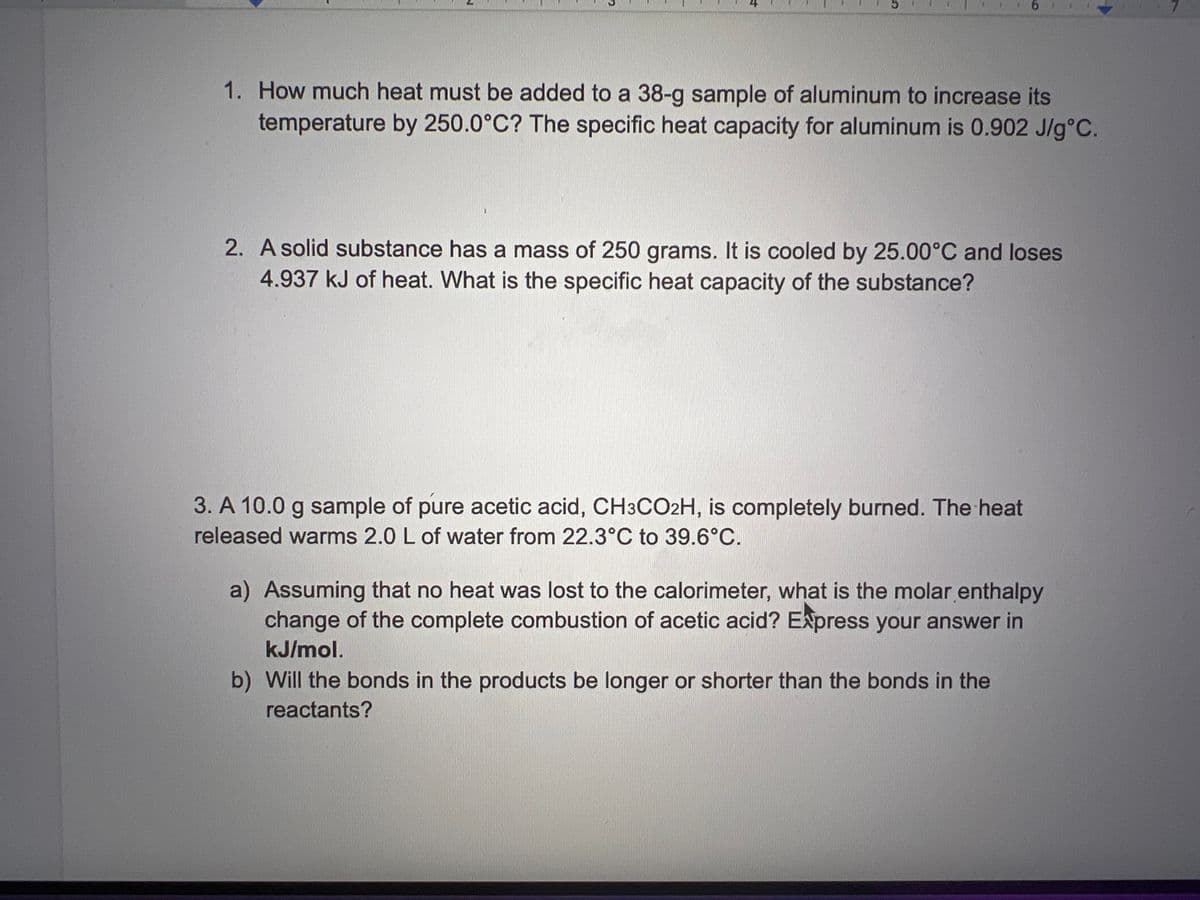1. How much heat must be added to a 38-g sample of aluminum to increase its temperature by 250.0°C? The specific heat capacity for aluminum is 0.902 J/g °C.
1. How much heat must be added to a 38-g sample of aluminum to increase its temperature by 250.0°C? The specific heat capacity for aluminum is 0.902 J/g °C.
Chemistry
10th Edition
ISBN:9781305957404
Author:Steven S. Zumdahl, Susan A. Zumdahl, Donald J. DeCoste
Publisher:Steven S. Zumdahl, Susan A. Zumdahl, Donald J. DeCoste
Chapter6: Thermochemistry
Section: Chapter Questions
Problem 64E: A 110.-g sample of copper (specific heat capacity = 0.20 J/C g) is heated to 82.4C and then placed...
Related questions
Question

Transcribed Image Text:1. How much heat must be added to a 38-g sample of aluminum to increase its
temperature by 250.0°C? The specific heat capacity for aluminum is 0.902 J/g °C.
6
2. A solid substance has a mass of 250 grams. It is cooled by 25.00°C and loses
4.937 kJ of heat. What is the specific heat capacity of the substance?
3. A 10.0 g sample of pure acetic acid, CH3CO2H, is completely burned. The heat
released warms 2.0 L of water from 22.3°C to 39.6°C.
a) Assuming that no heat was lost to the calorimeter, what is the molar enthalpy
change of the complete combustion of acetic acid? Express your answer in
kJ/mol.
b) Will the bonds in the products be longer or shorter than the bonds in the
reactants?
7
Expert Solution
This question has been solved!
Explore an expertly crafted, step-by-step solution for a thorough understanding of key concepts.
Step by step
Solved in 3 steps with 2 images

Knowledge Booster
Learn more about
Need a deep-dive on the concept behind this application? Look no further. Learn more about this topic, chemistry and related others by exploring similar questions and additional content below.Recommended textbooks for you

Chemistry
Chemistry
ISBN:
9781305957404
Author:
Steven S. Zumdahl, Susan A. Zumdahl, Donald J. DeCoste
Publisher:
Cengage Learning

Chemistry: An Atoms First Approach
Chemistry
ISBN:
9781305079243
Author:
Steven S. Zumdahl, Susan A. Zumdahl
Publisher:
Cengage Learning


Chemistry
Chemistry
ISBN:
9781305957404
Author:
Steven S. Zumdahl, Susan A. Zumdahl, Donald J. DeCoste
Publisher:
Cengage Learning

Chemistry: An Atoms First Approach
Chemistry
ISBN:
9781305079243
Author:
Steven S. Zumdahl, Susan A. Zumdahl
Publisher:
Cengage Learning


General Chemistry - Standalone book (MindTap Cour…
Chemistry
ISBN:
9781305580343
Author:
Steven D. Gammon, Ebbing, Darrell Ebbing, Steven D., Darrell; Gammon, Darrell Ebbing; Steven D. Gammon, Darrell D.; Gammon, Ebbing; Steven D. Gammon; Darrell
Publisher:
Cengage Learning

Chemistry by OpenStax (2015-05-04)
Chemistry
ISBN:
9781938168390
Author:
Klaus Theopold, Richard H Langley, Paul Flowers, William R. Robinson, Mark Blaser
Publisher:
OpenStax

Living By Chemistry: First Edition Textbook
Chemistry
ISBN:
9781559539418
Author:
Angelica Stacy
Publisher:
MAC HIGHER